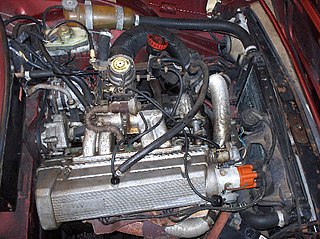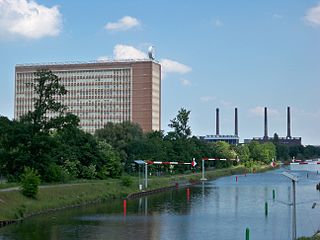
In a combustion engine, the static compression ratio is calculated based on the relative volumes of the combustion chamber and the cylinder. It is a fundamental specification for combustion engines. The dynamic compression ratio is a more advanced calculation which also takes into account gasses entering and exiting the cylinder during the compression phase.

Fuel injection is the introduction of fuel in an internal combustion engine, most commonly automotive engines, by the means of an injector.

In internal combustion engines, exhaust gas recirculation (EGR) is a nitrogen oxide (NO
x) emissions reduction technique used in petrol/gasoline and diesel engines. EGR works by recirculating a portion of an engine's exhaust gas back to the engine cylinders. This dilutes the O2 in the incoming air stream and provides gases inert to combustion to act as absorbents of combustion heat to reduce peak in-cylinder temperatures. NO
x is produced in high temperature mixtures of atmospheric nitrogen and oxygen that occur in the combustion cylinder, and this usually occurs at cylinder peak pressure. Another primary benefit of external EGR valves on a spark ignition engine is an increase in efficiency, as charge dilution allows a larger throttle position and reduces associated pumping losses.
A stratified charge engine describes a certain type of internal combustion engine, usually spark ignition (SI) engine that can be used in trucks, automobiles, portable and stationary equipment. The term "stratified charge" refers to the working fluids and fuel vapors entering the cylinder. Usually the fuel is injected into the cylinder or enters as a fuel rich vapor where a spark or other means are used to initiate ignition where the fuel rich zone interacts with the air to promote complete combustion. A stratified charge can allow for slightly higher compression ratios without "knock," and leaner air/fuel ratio than in conventional internal combustion engines.
Pre-ignition in a spark-ignition engine is a technically different phenomenon from engine knocking, and describes the event wherein the air/fuel mixture in the cylinder ignites before the spark plug fires. Pre-ignition is initiated by an ignition source other than the spark, such as hot spots in the combustion chamber, a spark plug that runs too hot for the application, or carbonaceous deposits in the combustion chamber heated to incandescence by previous engine combustion events.
Forced induction is the process of delivering compressed air to the intake of an internal combustion engine. A forced induction engine uses a gas compressor to increase the pressure, temperature and density of the air. An engine without forced induction is considered a naturally aspirated engine.
Indirect injection in an internal combustion engine is fuel injection where fuel is not directly injected into the combustion chamber. In the last decade, gasoline engines equipped with indirect injection systems, wherein a fuel injector delivers the fuel at some point before the intake valve, have mostly fallen out of favor to direct injection. However, certain manufacturers such as Volkswagen and Toyota have developed a 'dual injection' system, combining direct injectors with port (indirect) injectors, combining the benefits of both types of fuel injection. Direct injection allows the fuel to be precisely metered into the combustion chamber under high pressure which can lead to greater power, fuel efficiency. The issue with direct injection is that it typically leads to greater amounts of particulate matter and with the fuel no longer contacting the intake valves, carbon can accumulate on the intake valves over time. Adding indirect injection keeps fuel spraying on the intake valves, reducing or eliminating the carbon accumulation on intake valves and in low load conditions, indirect injection allows for better fuel-air mixing. This system is mainly used in higher cost models due to the added expense and complexity.
Lean-burn refers to the burning of fuel with an excess of air in an internal combustion engine. In lean-burn engines the air:fuel ratio may be as lean as 65:1. The air / fuel ratio needed to stoichiometrically combust gasoline, by contrast, is 14.64:1. The excess of air in a lean-burn engine emits far less hydrocarbons. High air–fuel ratios can also be used to reduce losses caused by other engine power management systems such as throttling losses.

Gasoline direct injection (GDI), is a form of fuel injection employed in modern two-stroke and four-stroke gasoline engines. The gasoline is highly pressurized, and injected via a common rail fuel line directly into the combustion chamber of each cylinder, as opposed to conventional multipoint fuel injection that injects fuel into the intake tract or cylinder port. Directly injecting fuel into the combustion chamber requires high-pressure injection, whereas low pressure is used injecting into the intake tract or cylinder port.
Homogeneous charge compression ignition (HCCI) is a form of internal combustion in which well-mixed fuel and oxidizer are compressed to the point of auto-ignition. As in other forms of combustion, this exothermic reaction releases energy that can be transformed in an engine into work and heat.
In internal combustion engines, water injection, also known as anti-detonant injection (ADI), can spray water into the incoming air or fuel-air mixture, or directly into the cylinder to cool certain parts of the induction system where "hot points" could produce premature ignition. In jet engines it increases engine thrust at low speeds and at takeoff.
Engine efficiency of thermal engines is the relationship between the total energy contained in the fuel, and the amount of energy used to perform useful work. There are two classifications of thermal engines-
- Internal combustion and
- External combustion engines.
The term six-stroke engine has been applied to a number of alternative internal combustion engine designs that attempt to improve on traditional two-stroke and four-stroke engines. Claimed advantages may include increased fuel efficiency, reduced mechanical complexity and/or reduced emissions. These engines can be divided into two groups based on the number of pistons that contribute to the six strokes.
Internal combustion engines come in a wide variety of types, but have certain family resemblances, and thus share many common types of components.
Engine downsizing is the use of a smaller engine in a vehicle that provides the power of a larger engine, through the use of recent technologies. It is the result of car manufacturers attempting to provide more efficient vehicles that emit less emissions, often given in by legalization. The term generally relates to traditional internal combustion engines powered by petrol or diesel.

An internal combustion engine (ICE) is a heat engine where the combustion of a fuel occurs with an oxidizer in a combustion chamber that is an integral part of the working fluid flow circuit. In an internal combustion engine, the expansion of the high-temperature and high-pressure gases produced by combustion applies direct force to some component of the engine. The force is applied typically to pistons, turbine blades, rotor or a nozzle. This force moves the component over a distance, transforming chemical energy into useful mechanical energy.
A tumble flap is a flap housed in the intake area of many modern automotive gasoline engines to produce a swirl at right-angles to the cylinder axis. This swirling motion improves the air-fuel mixture and enhances power and torque, while at the same time lowering fuel consumption and decreasing emissions. The flaps can be actuated with pneumatic or electric power. Furthermore, the position of the flap can be controlled continuously with a feedback controller or just kept either fully closed or open. Use of a tumble flap improves the lean burn ability of a spark-ignition engine.
The Audi RC8 2.0 TFSI is a mass-produced four-stroke 2.0-litre single-turbocharged inline-4 gasoline racing engine, developed and produced by Audi Sport GmbH for Deutsche Tourenwagen Masters. The RC8 2.0 TFSI engine is commonly based on Audi 2.0 R4 16v TSI/TFSI (EA888) road car engine. Audi RC8 TFSI was shakedowned on 15 November 2018 and later made public unveil on 20 March 2019 after more engine dyno test. Audi RC8 TFSI is the first-ever turbocharged DTM engine to date, replacing the aging Audi DTM V8 engine after nineteen-years of service which conform the "Class One" regulations that shared with Japanese Super GT.






